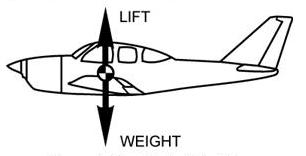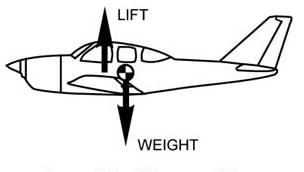Figure 1-22 illustrates neutral longitudinal stability. Note that
the center of lift is directly over the center of gravity or weight. An
airplane with neutral stability will produce no inherent pitch moments
around the center of gravity.

Longitudinal stability is important to the pilot because it determines to a great extent the pitch characteristics of the airplane, particularly as this relates to the stall characteristics. It would be unsafe and uncomfortable for the pilot if an airplane continually displayed a tendency to either stall or dive when the pilot’s attention was diverted for some reason. If properly designed, the airplane will not display these unstable tendencies when the airplane is loaded according to the manufacturer’s recommendations.
| The location of the center of gravity with respect to the
center of lift determines to a great extent the longitudinal stability
of the airplane.
Figure 1-22 illustrates neutral longitudinal stability. Note that
the center of lift is directly over the center of gravity or weight. An
airplane with neutral stability will produce no inherent pitch moments
around the center of gravity.
|
 |
|
|
 |
Figure 1-23 illustrates the center of lift in front of the center of
gravity. This airplane would display negative stability and an undesirable
pitchup moment during flight. If disturbed, the up and down pitching moment
will tend to increase in magnitude. This condition can occur, especially
if the airplane is loaded so that the center of gravity is rearward of
the airplane’s aft loading limits.
|
| Figure 1-23.—Negative stability. |
| Figure 1-24 shows an airplane with the center of lift behind the center of gravity. Again, this produces negative stability. Some force must balance the down force of the weight. This is accomplished by designing the airplane in such a manner that the air flowing downward behind the trailing edge of the wing strikes the upper surface of the horizontal stabilizer (except on T-tails which have the elevator located on the top instead of below the vertical fin). This creates a downward tail force to counteract the tendency to pitch down and provides positive stability. |
 |
|
|
The above concept is of prime importance to the pilot. A common misconception about longitudinal stability is that an airplane is stable in respect to the horizon. This would be an undesirable characteristic of an airplane. Keep in mind that longitudinal stability is with respect only to airspeed (angle of attack).
The foregoing explanation of longitudinal stability needs some qualification because during certain flight maneuvers, the airplane is not entirely “speed seeking,” but “angle of attack seeking.” This can be demonstrated by placing the airplane in a power-off glide and trimming the airplane for a specific speed. Then if the throttle is opened suddenly, the airplane will nose up and finally assume an attitude that results in a speed considerably less than that of the power-off glide. This is because of additional forces developed by the propeller blast over the horizontal stabilizer (except T-tails), and the fact that the airplane is stable only with relation to airflow, or the relative wind. In other words, the stable airplane is not concerned with its own attitude relative to the Earth or horizon, but with the relative wind. It will always tend to maintain an alignment with the relative wind.